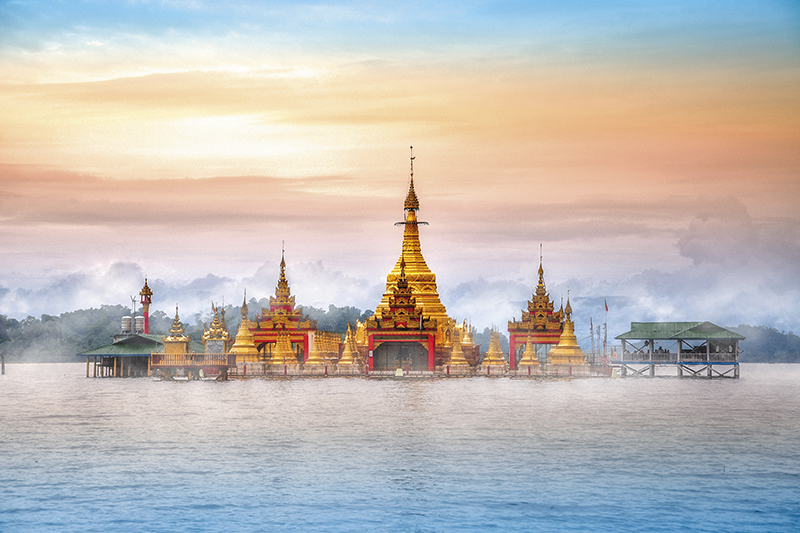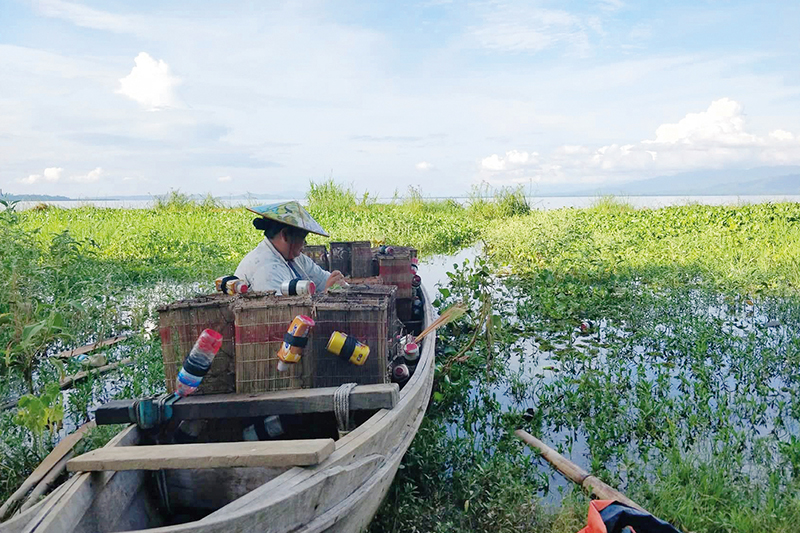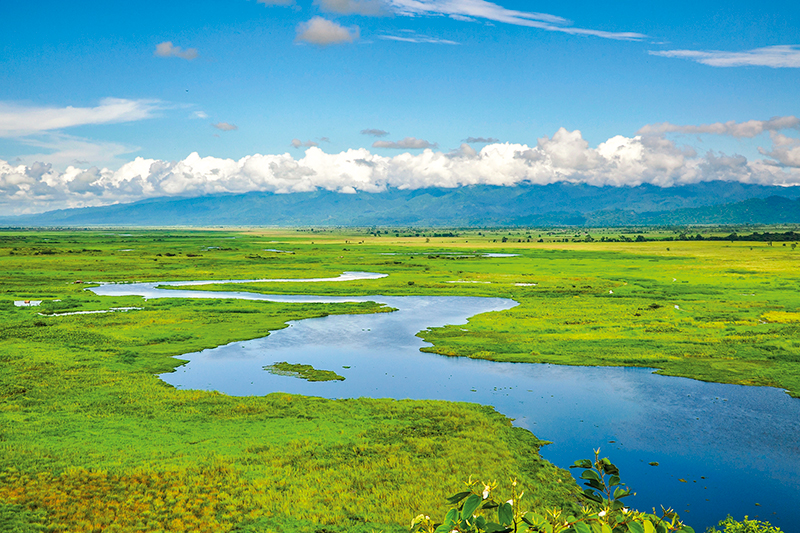
Indulgent Indawgyi Lake
Fascinating legends swirl around Myanmar’s biggest lake, Indawgyi, including a fable that it was once home to a massive dragon. This mother of all lakes generously nurtures a wildlife and bird sanctuary, while tranquil villages and surrounding verdant hills and mountains reveal an enchanting milieu of calm and spirituality as captivating as the tales around it.
Words Matthew Camilleri
Photos Matthew Camilleri, Shutterstock
It may be the monsoon, but we journeyed undeterred to Indawgyi Lake, one of the largest freshwater lakes in Southeast Asia. Located in Kachin state in the northern area of Myanmar, my gang and I expect a visual feast in this ‘green’ season. A bounty of fresh and green vegetables will flavour our Kachin and Shan dishes; and fun in the rain means swimming and playing football with the local kids. Best of all is the awe-inspiring vision of Shwe Myintzu temple looking like it floats on water as the lower water level at this time of year creates the mirage.
It’s a little over a one and a half hour flight from Yangon to Myitkyina, the Kachin state capital. From the airport, the trip to Indawgyi Lake requires an additional ride and taxi drivers await with fare prices that could give you a shock – 150,000 kyats (about US$100), as the asking price. But you can negotiate it down to about 80,000-90,000 kyats (around US$60).
Kachin state, in the northernmost part of Myanmar, bade welcome with landscape and mountain views spread out in blankets of green. After three and a half hours in the taxi passing through lush villages, we turned off toward Lon Ton, our destination. Lon, in the Kachin ethnic language means “coming down from the hills” and Ton, “finding food”, you’ll also hear it referred to as Indawgyi City. Lakeside teak houses on stilts remain, making a good base for the night but Lon Ton also lives up to its ethnic Shan Ni name with teashops, noodle shops and restaurants. For lunch, we ate a local pickled tea leaf salad, a chicken salad, and Kachin fried rice with an egg on the top. Like their sweet tea, everything was delicious.
To learn about the local crafts, we visit the village of Nunmun, stopping at a weaving place called Shwe Inn Lat Khat Tan. With many signature designs, the owner learned the craft in the ancient city of Amarapura, winning ‘best design of the year 2017’ in a countryside competition. Her colourful Burmese sarong, the longyi, fetches an affordable price of 13,000 kyats (around US$8.6) Nearby is a local primary school where children are taught to read and write in the indigenous language of Shan Ni (Tai Lan), thereby preserving local traditions and culture.

We make it to Indawgyi Lake itself, whose waters offer a calming welcome ringed by the green mountains on its edges. It measures 3 kilometres east to west, and 24 kilometres north to south, large enough for the 21 small villages to site calmly on its banks. The map indicates an area rich in local fish and turtle species, and a paradise for birds. During the winter, 20,000 migratory birds from the north do their seasonal layover, making it ideal for birdwatching at the Wildlife Sanctuary, as waterbirds share the vast space with their visitors.
At a separate point at the lake, we run into a shrimp catcher in a boat with her wooden traps. With her colourful conical hat, we noted her use of ground beans for bait and soda bottles as floats. The traps get dropped-before dawn and the amount caught gets sold at the local market the next morning. “I’ve been doing this for years and it’s how I feed my family,” she says. Once these traps are submerged, the floating tops bob gently in unison – capturing the early rays of the sunrise across the lake.
Having pre-booked an early morning boat, we finally make our way to Shwe Myintzu pagoda. Within 20 minutes, a cluster of small pagodas appear from the middle of the lake. We arrive at the temple dock where two bells hang, supported by a pole that’s underwater. Disembarking the boat, wading through water and exploring the pagoda compound feels amazing. The ceramic tiles surrounding the temple stay dry in the summer, functioning like a regular platform. However, the monsoon offers a different experience as you walk over the rippling colours. Awestruck by the view, we see an infinity point where the lake meets the horizon.
You can take a tour around the smaller pagodas in the area. Nearby is the boat-building community of Hepa requires traversing through quiet waterways on the east side of the lake. Natural foliage and trees spread across tranquil waters like an enchanted forest as boats gently dance on the surface.
The lake’s beauty, its blue waters and romanticism are further enhanced by the mystical tales that have been circulated for decades. Today’s waters look deceptively calm, but the stories tell of dragons or nagas that inhabit the lake before, together with the Shan Ni (Red Shan) people, also known as the Tai Leng, who lived with their emperor who reigned during the 16th century.

To view the lake from another angle, we visit a monastery, close to the village of Lwemum and an ideal stop for our group to enjoy fresh coconuts beside the mountain road to the village of Nammilaung. In this ‘no-plastic’ zone, no disposable cups are seen and bamboo straws rest inside our coconuts.
Once above, heavenly mountains spread across the lake, seen from the vantage point of Shwe Taung pagoa as it sits on a hilltop by the lake, and surrounded by a forest. A smaller pagoda with a wooden spirit statue and a small dock where people washed and swam called to us. My colleagues and I jumped into the water and had a fun time. The dreamy landscape was right for mythical creatures but we didn’t see a single dragon or naga!
A monk and his novice shared the history of the lake and magical Shwe Myintzu pagoda. It was once a village inhabited by the ethnic Shan people who transformed into tigers with just a roll down the hill. A widow had dreamt of a major flood and warned everyone. No one believed in the premonition, so she left for higher ground with her son. Once safe on the hills, she looked back to see a whole village flooded and everyone gone. As the story goes, people turned into fishes. “You could see these fishes with human teeth and their golden scales around the pagoda where they used to come and pray.”
On the way back to the homestay, we passed scenery akin to the shire in ‘The Hobbit’ movie; with green mountains and fields and clouds surrounding Indawgyi. Farms appear on the sides of slopes, top of mountain ridges and even in some valleys where no vehicle can reach. Overgrown jungles hide fruit plantations, abundant with citrus fruits like the pomelo.
It’s time to return to Myitkyina in a small truck. But just before leaving, the owner conveys an invitation to a birthday party for a one-year-old child, just two houses down. The buffet breakfast includes some Kachin and Burmese dishes, vegetables and desserts, all delicious treats and hospitality. With stomachs full, we bid farewell, waving back to the good people of Indawgyi and its bountiful lake.
Getting there:
A domestic flight from Mandalay to Myitkyina take 1.10 hours and from Yangon to Myityina take 1.35 hours, and the ‘fastest’ way from the airport; taxis go to the lake for around 90,000 kyats one way, do negotiate.
A bus from Yangon to Myitkyina takes 22 hours, with another five hours to Indawgyi Lake. A ticket costs around 43,000 kyats or US$23. Tickets are available at mandalarminn.com.mm and rome2rio.com
From Mandalay, trains are available for the 20-hour trip to Myitkyina, with a ticket price of US$16, myanmartrainticket.com
Accommodations:
Homestays (10,000 kyats or around US$6.6 per night for each guest)
Note: A stop at the military checkpoint on the way to the lake is required to show your passport and ID if you’re a foreigner. Strictly no photos should be taken around the gate.

ทะเลสาบอินดอจี เมืองโมญีน ในรัฐคะฉิ่นเป็นทะเลสาบอันเงียบสงบที่ใหญ่ที่สุดในประเทศเมียนมา นอกจากจะเป็นแหล่งน้ำหล่อเลี้ยงสัตว์ป่าน้อยใหญ่และผู้คนจากหมู่บ้านต่างๆ โดยรอบแล้ว ทะเลสาบแห่งนี้ยังเป็นจุดเริ่มต้นแห่งตำนานพญานาคอันน่าเกรงขามอีกด้วย
ถึงจะเป็นฤดูมรสุม แต่เราก็ตัดสินใจไปเยี่ยมเยือนทะเลสาบอินดอจีเพื่อชื่นชมความงดงามในช่วงฤดูกาล “สีเขียว” ฤดูกาลที่พืชพรรณนานาชาติผลิดอกออกใบรับฝนฉ่ำ เรายังหวังจะได้โอกาสลิ้มรสอาหารคะฉิ่นและฉานอันโอชะ ได้วิ่งเล่นเตะฟุตบอลกับเด็กๆ ท่ามกลางสายฝนเหนืออื่นใด ได้ไปชมเจดีย์ชเวมิตซุ สีทองตัดแดง ที่เหมือน “ลอย” อยู่ในน้ำ
เราขึ้นเครื่องไปลงที่สนามบินในมยิจีนา เมืองหลวงของรัฐคะฉิ่น ด้านนอกสนามบินมีรถแท็กซี่จอดรอมากมาย อย่าตกใจถ้าถูกเรียกค่าโดยสารแพงหูฉี่ถึง 3,000 บาท เพราะคุณสามารถต่อราคาได้ถึง 80,000 จัต หรือประมาณ 1,600 บาท ถูกลงเกือบครึ่ง
รัฐคะฉิ่น ณ ตอนเหนือสุดของเมียนมา ต้อนรับนักท่องเที่ยวทุกคนด้วยผืนป่าเขียวขจี เมฆปกคลุมท้องฟ้า หลังจากนั่งรถแท็กซี่มาสามชั่วโมงครึ่ง เราก็มาถึงหมู่บ้านโลนตอนที่เราจะพักในคืนนี้ มื้อเที่ยวเราแวะทานยำใบชาดอง ยำไก่ และข้าวผัดคะฉิ่นโปะหน้าด้วยไข่ดาว ซึ่งอร่อยทุกจานและชาก็รสหวานอร่อยอย่าบอกใคร
เราไปต่อที่หมู่บ้านนันมันเพื่อชมความประณีตของลายทอผ้าโบราณที่สืบทอดมาจากอมรปุระ โสร่งหนึ่งผืนราคาเพียง 13,000 จัต หรือประมาณ 275 บาทเท่านั้น
จากนั้นก็ไปเยี่ยมชมโรงเรียนประถมศึกษาแห่งหนึ่ง ก่อนหน้านี้รัฐบาลห้ามไม่ให้มีการเรียนการสอนภาษาถิ่นชานนี แต่ปัจจุบันครูผู้สอนจะต้องผ่านหลักสูตรการสอนภาษาชานนีก่อนจึงจะสามารถสอนในโรงเรียนได้
เช้าตรู่วันรุ่งขึ้น เรานั่งเรือ 20 นาที ไปยังเจดีย์ชเวมิตซุกลางน้ำที่มีเจดีย์น้อยใหญ่ประดับกระเบื้องตั้งอยู่รายรอบท่ามกลางทะเลสาบที่กว้างสุดลูกหูลูกตา
ตื่นตากับบ้านใต้ถุนสูงในหมู่บ้านเฮปาพร้อมกับวิวภูเขาเป็นฉากหลัง ภาพวิถีชีวิตของชาวบ้านกำลังต่อเรือเพื่อนำไปขายยังหมู่บ้านอื่นและช่างต่อเรือรุ่นใหม่ที่เรียนรู้จากครู สืบสานภูมิปัญญาที่สืบทอดกันมาช้านาน
เราไปต่อที่ลเวมัม ผ่านวิวภูเขาที่ทอดยาวผ่านทะเลสาบ แล้วแวะสำนักสงฆ์ที่ชาวบ้านเชื่อว่ามีอุโมงค์ใต้น้ำทะลุไปยังทะเลสาบอินดอจี เป็นทางที่พญานาคใช้เพื่อมาหาลูกชาย มองขึ้นไปบนเขาจะเห็นเจดีย์ชเว ตอง ตรงไหล่เขามีรูปเคารพไม้และท่าน้ำที่ชาวบ้านใช้อาบน้ำและซักล้าง
พระท่านได้เล่าถึงตำนานของเจดีย์ชเวมิตซุว่า เมื่อก่อนเคยมีชาวฉานอาศัยอยู่บริเวณนั้น วันหนึ่งแม่หม้ายฝันว่าน้ำจะท่วมหมู่บ้าน พูดเตือนชาวบ้านแต่ไม่มีใครเชื่อ เธอจึงพาลูกชายหนีขึ้นไปบนเขาแล้วมองดูหมู่บ้านจมอยู่ใต้บาดาล ชาวบ้านที่จมน้ำได้กลายเป็นปลาแหวกว่ายอยู่รอบๆ เจดีย์แห่งนี้
หลังจากที่ได้ฟังตำนาน เราขี่รถกลับมาท่ามกลางวิวทิวทัศน์ที่เหมือนกับในหนังฮอบบิตอย่างไรอย่างนั้น ในวันรุ่งขึ้น เราได้รับเชิญให้ไปร่วมงานเลี้ยงวันเกิดของเด็กหนึ่งขวบไม่ห่างจากที่พักมากนัก ได้ลิ้มรสอาหารพม่าและคะฉิ่น ทั้งผักและของหวานอร่อยดีแท้ แล้วเราก็โบกมือลาชาวอินดอจีโดยหวังว่าจะได้พบกันใหม่เร็วๆ นี้
การเดินทาง:
นั่งเครื่องบินภายในประเทศจากมัณฑะเลย์-มยิจีนา ใช้เวลา 1 ชั่วโมง 10 นาที และ ย่างกุ้ง-มยิจีนาใช้เวลา 1 ชั่วโมง 35 นาที แล้วต่อแท็กซี่ไปยังทะลสาบอินดอจี สามารถเช่ามอเตอร์ไซค์เพื่อเดินทางในหมู่บ้านหรือไปยังทะเลสาบก็สะดวกดี
รสบัส จากย่างกุ้ง-มยิจีนา ใช้เวลา 22 ชั่วโมง และอีก 5 ชั่วโมง มายังทะเลสาบอินดอจี
รถไฟจากมัณฑะเลย์-มยิจีนา ใช้เวลา 20 ชั่วโมง
ที่พัก:
โฮมเสตย์ (10,000 จัต หรือราว 200 บาท/คน/คืน)
ข้อควรรู้: อย่าลืมต่อราคาแท็กซี่ แล้วก็ต้องหยุดที่จุดตรวจของทหารเพื่อตรวจพาสปอร์ตและเอกสารแสดงตัวตน ห้ามถ่ายภาพบริเวณด่านเด็ดขาด
